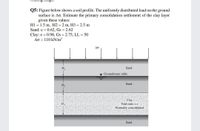
Structural Analysis
6th Edition
ISBN: 9781337630931
Author: KASSIMALI, Aslam.
Publisher: Cengage,
expand_more
expand_more
format_list_bulleted
Concept explainers
Question
Maheusaiac:: — Dadames i Q5: Figure below shows a soil profile. The uniformly distributed load on the ground surface is Ac. Estimate the primary consolidation settlement of the clay layer given these values: Hl=15m, H2=2m,H3=25m Sand 0.62, Gs = 2.62 Clay: 0.98, Gs =2.75, LL = 50 Ac =110 kN/m* Ao H, Sand Groundwater table

Transcribed Image Text:Q5: Figure below shows a soil profile. The uniformly distributed load on the ground
surface is Ao. Estimate the primary consolidation settlement of the clay layer
given these values:
H1 = 1.5 m, H2 = 2 m, H3 = 2.5 m
Sand: e = 0.62, Gs = 2.62
Clay: e = 0.98, Gs = 2.75, LL = 50
Ao = 110 kN/m2
H1
Sand
Groundwater table
Sand
H2
Clay
Void ratio = e
Normally consolidated
Sand
Expert Solution
This question has been solved!
Explore an expertly crafted, step-by-step solution for a thorough understanding of key concepts.
This is a popular solution
Trending nowThis is a popular solution!
Step by stepSolved in 4 steps with 5 images

Knowledge Booster
Learn more about
Need a deep-dive on the concept behind this application? Look no further. Learn more about this topic, civil-engineering and related others by exploring similar questions and additional content below.Similar questions
- The soil profile shown below is subjected to a uniformly distributed load (UDL) on ground surface of 600 kN/m². The underground soil consist of two normally consolidated clay (N.C.C.) layers, and between them one sand layer with properties as shown on the figure. If the ground water table is at the ground surface, and the (AP) assumed to be the same at both clay layers, Calculate the total consolidation settlement Sc from the two clay layer? assume compression index, Cc=0.007(LL-10). 4.0 m 3.0 m 2.0 m Clay Sand Clay AP=600 kN/m² W, 35%. LL-40%. G.-2.65 Ys at = 18 kN/m³ W, 40, LL=45%, G,-2.78 ▼ G.W.Tarrow_forwardQ 8.7 If the coefficient of consolidation for the clay layer in problem 8.3 is 0.0018 cm^2/Sec, how long will it take for 60% primary consolidation to take place? What will be the total compression due to consolidation at that time?arrow_forwardThe thickness of a saturated specimen of clay under a consolidation pressure of 100 kN/m2 of is 24 mm and its water content is 20%. On increase of the consolidation pressure to 200 kN/m2, the specimen thickness decreases by 3 mm. Determine the compression index for the soil if the specific gravity of the soil grains is 2.70. a.0.92 b.0.56 c.0.63 d.0.52arrow_forward
Recommended textbooks for you

 Structural Analysis (10th Edition)Civil EngineeringISBN:9780134610672Author:Russell C. HibbelerPublisher:PEARSON
Structural Analysis (10th Edition)Civil EngineeringISBN:9780134610672Author:Russell C. HibbelerPublisher:PEARSON Principles of Foundation Engineering (MindTap Cou...Civil EngineeringISBN:9781337705028Author:Braja M. Das, Nagaratnam SivakuganPublisher:Cengage Learning
Principles of Foundation Engineering (MindTap Cou...Civil EngineeringISBN:9781337705028Author:Braja M. Das, Nagaratnam SivakuganPublisher:Cengage Learning Fundamentals of Structural AnalysisCivil EngineeringISBN:9780073398006Author:Kenneth M. Leet Emeritus, Chia-Ming Uang, Joel LanningPublisher:McGraw-Hill Education
Fundamentals of Structural AnalysisCivil EngineeringISBN:9780073398006Author:Kenneth M. Leet Emeritus, Chia-Ming Uang, Joel LanningPublisher:McGraw-Hill Education
 Traffic and Highway EngineeringCivil EngineeringISBN:9781305156241Author:Garber, Nicholas J.Publisher:Cengage Learning
Traffic and Highway EngineeringCivil EngineeringISBN:9781305156241Author:Garber, Nicholas J.Publisher:Cengage Learning


Structural Analysis (10th Edition)
Civil Engineering
ISBN:9780134610672
Author:Russell C. Hibbeler
Publisher:PEARSON

Principles of Foundation Engineering (MindTap Cou...
Civil Engineering
ISBN:9781337705028
Author:Braja M. Das, Nagaratnam Sivakugan
Publisher:Cengage Learning

Fundamentals of Structural Analysis
Civil Engineering
ISBN:9780073398006
Author:Kenneth M. Leet Emeritus, Chia-Ming Uang, Joel Lanning
Publisher:McGraw-Hill Education


Traffic and Highway Engineering
Civil Engineering
ISBN:9781305156241
Author:Garber, Nicholas J.
Publisher:Cengage Learning